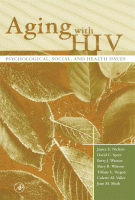Browse content
Table of contents
Actions for selected chapters
- Full text access
- Book chapterAbstract only
Chapter 1 - HIV/AIDS in Middle-Aged and Older Adults: A Research Response
Pages 1-13 - Book chapterAbstract only
Chapter 2 - Findings from the West Central Florida Survey of Middle-Aged and Older Adults with HIV Disease
Pages 15-32 - Book chapterAbstract only
Chapter 3 - The Experience of Older Adults Living with HIV
Pages 33-81 - Book chapterAbstract only
Chapter 4 - Overview of the Biomedical Aspects of HIV and Its Impact on Older Adults
Pages 83-111 - Book chapterAbstract only
Chapter 5 - HIV-Related Stressors, Coping, and Social Support
Pages 113-132 - Book chapterAbstract only
Chapter 6 - Mental Health and HIV
Pages 133-155 - Book chapterAbstract only
Chapter 7 - Providing Services to Older Adults with HIV Disease
Pages 157-196 - Book chapterAbstract only
Chapter 8 - People of Color: HIV Prevention and Treatment Issues
Pages 197-227 - Book chapterAbstract only
Chapter 9 - Effects of HIV Disease on Women
Pages 229-246 - Book chapterAbstract only
Chapter 10 - Older Adult Sexuality and HIV
Pages 247-264 - Book chapterAbstract only
Chapter 11 - End of Life Issues
Pages 265-283 - Book chapterAbstract only
Chapter 12 - HIV Prevention and Outreach
Pages 285-309 - Book chapterAbstract only
Chapter 13 - In Conclusion
Pages 311-325 - Book chapterNo access
Appendix A - Middle-Aged and Older Adults with HIV Disease: West Central Florida Survey Project Description and Results
Pages 327-358 - Book chapterNo access
Appendix B - Older Adult HIV/AIDS Interview Schedule
Pages 359-380 - Book chapterNo access
Index
Pages 381-386
About the book
Description
In 1998, approximately 30 million people worldwide were living with HIV/AIDS, about 5 million of whom became infected that year. The epidemic continues to expand, with an estimated doubling time of 10 years, making AIDS the leading infectious cause of death ahead of tuberculosis and malaria. Even in the U.S.A. where the death rate from AIDS is declining as a result of effective drug therapies, HIV infection rates continue to climb in several population groups. The prevalence of AIDS among people over the age of 50 is steadily increasing, and most older people are unprepared to address it for a number of reasons, including the widespread discomfort with matters sexual and homosexual and the belief that elderly people are not sexually active and therefore not at risk.
This guide for care providers seeks to educate and inform readers about the difficulties and complications that accompany the disease in older people. Thus, while the appendix includes technical descriptions of methodology, data, and results, the narratives in the chapters describing the findings and their practical implications are written in layman's language. Topics covered include biomedical aspects, demographics, sexuality, stressors, mental health, older women, and patient care, all of which are supported by case studies.
In 1998, approximately 30 million people worldwide were living with HIV/AIDS, about 5 million of whom became infected that year. The epidemic continues to expand, with an estimated doubling time of 10 years, making AIDS the leading infectious cause of death ahead of tuberculosis and malaria. Even in the U.S.A. where the death rate from AIDS is declining as a result of effective drug therapies, HIV infection rates continue to climb in several population groups. The prevalence of AIDS among people over the age of 50 is steadily increasing, and most older people are unprepared to address it for a number of reasons, including the widespread discomfort with matters sexual and homosexual and the belief that elderly people are not sexually active and therefore not at risk.
This guide for care providers seeks to educate and inform readers about the difficulties and complications that accompany the disease in older people. Thus, while the appendix includes technical descriptions of methodology, data, and results, the narratives in the chapters describing the findings and their practical implications are written in layman's language. Topics covered include biomedical aspects, demographics, sexuality, stressors, mental health, older women, and patient care, all of which are supported by case studies.
Details
ISBN
978-0-12-518051-1
Language
English
Published
2002
Copyright
Copyright © 2002 Elsevier Inc. All rights reserved
Imprint
Academic Press
